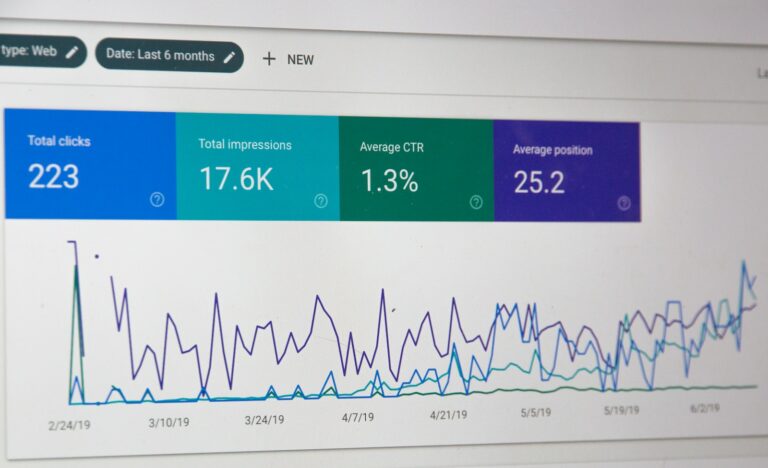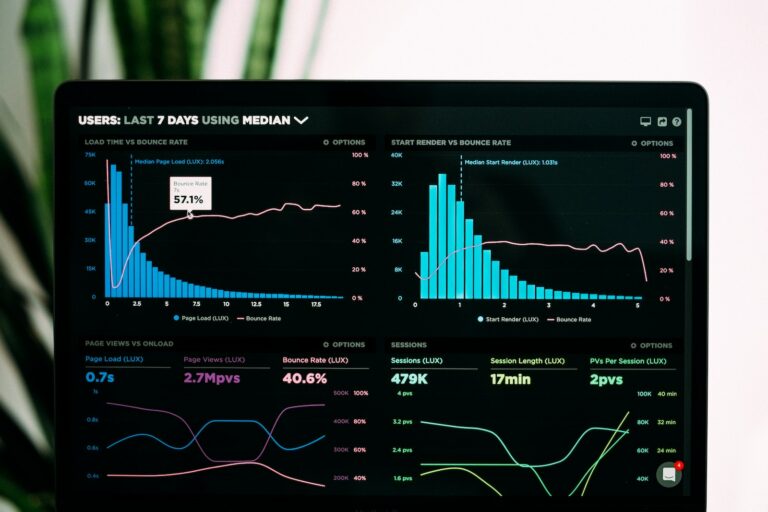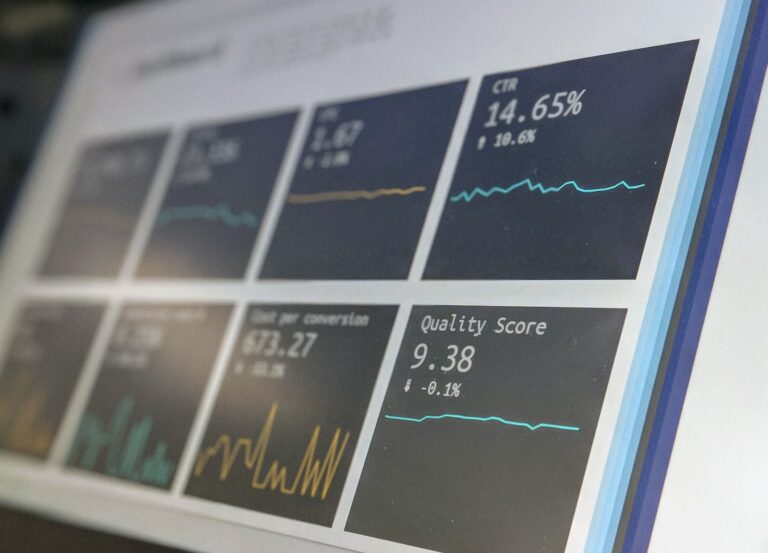“The Ultimate Guide: How to Track Website Traffic Using Google Analytics” is a comprehensive and informative article that provides invaluable insights on effectively monitoring website traffic through the use of Google Analytics. This essential guide equips readers with the necessary knowledge to navigate the vast array of features and tools offered by Google Analytics, enabling them to gain a deeper understanding of their website’s performance. By following the step-by-step instructions outlined in this article, individuals and businesses alike can harness the power of Google Analytics to optimize their online presence and drive success.

Setting Up Google Analytics
Creating a Google Analytics account
Setting up Google Analytics is the first step towards tracking website traffic effectively. To create a Google Analytics account, an individual or organization needs to have a Google account. Once the Google account is in place, the user can navigate to the Google Analytics website and sign in using their Google credentials. From there, they can create a new Google Analytics account by providing the necessary information, such as the website name, URL, and industry category.
Installing Google Analytics tracking code on your website
Once the Google Analytics account is created, the next step is to install the tracking code on the website. This code is provided by Google Analytics and needs to be embedded in the website’s HTML. The tracking code is responsible for collecting and sending data to the Google Analytics servers, where it is processed and analyzed. It is crucial to ensure that the tracking code is placed on every page of the website to accurately track the entire website’s traffic.
Verifying the tracking code installation
After installing the tracking code, it is essential to verify if it is installed correctly and functional. Google Analytics provides a feature called Real-Time reporting, which allows users to monitor the traffic data in real time. By accessing the Real-Time reports, users can see if their website is sending data to Google Analytics. Verifying the tracking code installation ensures that the website’s data is being accurately tracked, and any issues with the installation can be addressed promptly.
Understanding Google Analytics
Navigating the Google Analytics dashboard
Google Analytics provides a comprehensive dashboard that displays various reports and insights about a website’s performance. Navigating through the dashboard is essential to access the different sections and reports available. The dashboard consists of a sidebar menu, where users can find different categories and sections, such as Real-Time, Audience, Acquisition, Behavior, and Conversions. By familiarizing themselves with the dashboard’s layout, users can easily access the specific information they need to analyze and track website traffic effectively.
Understanding the different sections and reports
Google Analytics offers a wide range of sections and reports, each providing distinct insights into website performance. The Audience section offers demographic and geographic information about the website’s visitors, helping users understand their target audience. The Acquisition section focuses on traffic sources, providing valuable information about where users are coming from, such as organic search, direct traffic, or referrals. The Behavior section provides insights into user engagement metrics, including the average time spent on the website, bounce rate, and behavior flow. Lastly, the Conversions section allows users to set up goals and track the conversion rate, enabling them to measure the effectiveness of their website’s objectives.
Customizing your dashboard layout
Google Analytics allows users to customize their dashboard layout to prioritize the reports and information that are most relevant to their website’s goals. Users can add or remove widgets, rearrange them, and resize them to create a customized dashboard that suits their preferences and requirements. By customizing the dashboard layout, users can have quick access to the reports and metrics that are essential for tracking website traffic effectively, ensuring they are focusing on the most critical data for their analysis.

Setting Up Goals
Defining your website goals
Setting up goals in Google Analytics is crucial for tracking and measuring the success of specific actions or conversions on a website. Before creating goals, it is essential to identify and define the website goals that align with the overall objectives. This could include goals such as e-commerce transactions, form submissions, newsletter sign-ups, or specific page views. Defining clear and measurable goals enables users to track and analyze the progress toward achieving these objectives effectively.
Creating goal templates in Google Analytics
Google Analytics offers various goal templates that users can utilize to create goals quickly. These templates are tailored to common website objectives and provide a starting point for setting up goals. Users can choose a relevant template and customize it to fit their specific requirements. By using goal templates, users can save time and ensure that goals are properly configured based on best practices and industry standards.
Configuring goal settings
Once the goals are defined and the template is selected, users need to configure the goal settings to match their website’s specific actions or conversions. Goal settings include parameters such as the goal name, goal type (such as destination, duration, or event), and the specific details related to the chosen type. For example, if the goal is a destination, users need to specify the URL of the page that indicates goal completion. Configuring goal settings accurately allows Google Analytics to track and report the progress toward achieving these goals effectively.
Tracking Website Traffic
Monitoring real-time website traffic
Google Analytics provides real-time reporting, allowing users to monitor website traffic as it happens. Real-time reports provide insights into the number of active users on the website, the pages they are viewing, their geographical location, and the traffic sources they are coming from. Monitoring real-time website traffic helps users understand the immediate impact of marketing campaigns, website changes, or any other events on their website’s traffic. It allows for quick analysis and adjustments to optimize website performance in real time.
Analyzing historical website traffic
In addition to real-time reporting, Google Analytics also provides historical data about website traffic. Users can access reports that present data over various time periods, such as hours, days, weeks, months, or custom date ranges. Analyzing historical website traffic allows users to identify trends and patterns, understand the website’s performance over time, and make informed decisions based on past data. By comparing different time periods and analyzing historical trends, users can gain valuable insights into the impact of marketing strategies, seasonal variations, or other factors on website traffic.
Identifying traffic sources and channels
Google Analytics categorizes website traffic into different sources and channels to provide a comprehensive understanding of where users are coming from. Traffic sources include organic search, direct traffic, referrals, social media, paid search, and others. Channels offer a more specific breakdown of the traffic sources, providing insights into the effectiveness of different marketing channels, campaigns, or strategies. By identifying the traffic sources and channels, users can determine which sources are driving the most valuable and relevant traffic to their website, allowing them to optimize their marketing efforts accordingly.

Analyzing Audience and User Behavior
Demographic and geographic insights
Google Analytics provides valuable demographic and geographic insights about the website’s audience. Demographic information includes data such as age, gender, and interests, while geographic information provides details about the geographical location of the website visitors. Analyzing these insights helps users understand their target audience better, tailor their marketing strategies to specific demographics or locations, and improve their website’s relevance and effectiveness for the target audience.
Engagement metrics and behavior flow
Engagement metrics, such as average time on page, bounce rate, and pages per session, provide insights into how users interact with the website. Google Analytics also offers a behavior flow report, which visualizes the path users take through the website. Analyzing engagement metrics and behavior flow helps users identify areas of their website where users may encounter difficulties, navigate away, or spend less time. By understanding the user behavior on the website, users can optimize the website’s structure, content, and user experience, improving engagement and conversions.
Analyzing user acquisition and retention
User acquisition and retention reports in Google Analytics provide insights into how users are acquired and retained on the website. These reports offer valuable data about user acquisition channels, such as organic search, referrals, direct traffic, and social media. Additionally, retention reports measure user behavior over time, allowing users to analyze how often users return to the website and the rate at which they churn. By analyzing user acquisition and retention data, users can refine their marketing strategies, improve customer loyalty, and attract new visitors to their websites.
Understanding Referral Traffic
Analyzing inbound links
Referral traffic refers to the visitors who come to a website through a link on another website. Analyzing inbound links provides insights into which websites are referring traffic to the website being tracked. Google Analytics offers a referral report that displays the top referral sources, allowing users to identify the websites that are sending the most traffic. By analyzing inbound links, users can determine the effectiveness of their partnership or promotional efforts with other websites and optimize their referral traffic strategy.
Identifying top referral sources
Google Analytics allows users to identify the top referral sources, helping them understand which websites are driving the most traffic. This information is crucial for building relationships with high-performing referral sources, exploring potential partnerships, or optimizing marketing efforts that generate referral traffic. By identifying the top referral sources, users can focus their attention on the most valuable traffic sources and allocate resources accordingly.
Measuring referral traffic performance
Measuring the performance of referral traffic is essential for tracking the effectiveness of partnerships, collaborations, or promotional efforts. Google Analytics provides various metrics to assess referral traffic, such as the number of sessions, bounce rate, average session duration, and conversion rate. By measuring referral traffic performance, users can evaluate the impact of their referral strategies, identify areas for improvement, and make informed decisions to optimize their referral traffic efforts.
Monitoring Organic Search Traffic
Setting up Google Search Console integration
Integrating Google Search Console with Google Analytics allows users to access more detailed information about organic search traffic. Google Search Console provides insights into the website’s performance on Google’s search engine, including keyword rankings, impressions, and click-through rates. By setting up this integration, users can benefit from a more comprehensive understanding of their organic search traffic, enabling them to optimize their SEO strategies and improve search engine visibility.
Analyzing keyword rankings and impressions
With the integration of Google Search Console, users can analyze keyword rankings and impressions. Keyword rankings indicate the position of the website in search engine results for specific keywords, providing insights into the website’s visibility. Impressions represent the number of times the website appeared in search results, regardless of whether users clicked on the link. By analyzing keyword rankings and impressions, users can identify opportunities to improve their organic search performance, optimize content for targeted keywords, and increase website visibility.
Measuring organic search traffic performance
Google Analytics measures various metrics related to organic search traffic, enabling users to assess its performance. These metrics include the number of organic sessions, the organic bounce rate, the average session duration, and the conversion rate for organic traffic. By measuring organic search traffic performance, users can evaluate the effectiveness of their SEO efforts, identify areas for improvement, and make data-driven decisions to enhance the website’s organic visibility and performance.
Analyzing Paid Search Traffic
Linking Google Ads to Google Analytics
Linking Google Ads to Google Analytics allows users to access comprehensive data about their paid search campaigns. By linking the two platforms, users can view data from the Google Ads campaigns directly within Google Analytics, gaining insights into the performance of their paid search traffic. This integration offers a holistic view of the website’s traffic and allows for more accurate analysis of paid search campaigns, enabling users to refine their strategies and optimize their advertising spend.
Analyzing paid keyword performance
With the integration between Google Ads and Google Analytics, users can analyze the performance of paid keywords. Paid keyword performance includes metrics such as clicks, impressions, click-through rate (CTR), conversions, and cost per click (CPC). By analyzing paid keyword performance, users can determine the effectiveness of their keyword targeting, identify high-performing keywords, adjust bids, and optimize their paid search campaigns to improve ROI.
Measuring paid search traffic performance
Google Analytics provides various metrics to measure the performance of paid search traffic. These metrics include the number of sessions from paid search, the bounce rate of paid traffic, the average session duration, and the conversion rate for paid search. By measuring paid search traffic performance, users can assess the effectiveness of their paid search campaigns, evaluate the ROI of their advertising efforts, and make informed decisions to optimize their paid search strategies.
Measuring Social Media Traffic
Tracking social media traffic sources
Google Analytics offers the ability to track and analyze social media traffic sources. Users can identify the social media platforms that are driving traffic to their website, such as Facebook, Twitter, Instagram, or LinkedIn. By tracking social media traffic sources, users can determine the effectiveness of their social media marketing efforts, understand which platforms are generating the most traffic, and optimize their social media strategies to improve engagement and conversions.
Analyzing social media referral traffic
In addition to tracking social media traffic sources, Google Analytics allows users to analyze social media referral traffic. This includes metrics such as the number of sessions, the bounce rate, the average session duration, and the conversion rate for social media referrals. By analyzing social media referral traffic, users can evaluate the impact of their social media marketing campaigns, identify the most successful content or campaigns, and make data-driven decisions to optimize their social media strategies.
Measuring social media traffic performance
Measuring the performance of social media traffic is essential for tracking the effectiveness of social media marketing efforts. Google Analytics provides various metrics to assess social media traffic performance, such as the number of sessions, the bounce rate, the average session duration, and the conversion rate for social media traffic. By measuring social media traffic performance, users can gauge the success of their social media marketing campaigns, identify areas for improvement, and optimize their social media strategies to maximize ROI.
Monitoring Mobile Traffic
Understanding mobile user behavior
With the increasing use of mobile devices, monitoring mobile traffic has become crucial for website owners. Google Analytics provides insights into mobile user behavior, including metrics such as the number of sessions, bounce rate, average session duration, and conversion rate for mobile traffic. By understanding mobile user behavior, website owners can optimize their website’s mobile responsiveness, user experience, and performance, ensuring a seamless and engaging experience for mobile visitors.
Analyzing mobile traffic sources
Google Analytics allows users to analyze mobile traffic sources, providing insights into which sources are driving mobile visitors to the website. This includes traffic originating from organic search, referrals, direct traffic, social media, or paid search. By analyzing mobile traffic sources, website owners can identify the most effective channels for attracting mobile visitors, optimize their mobile marketing strategies, and allocate resources accordingly.
Measuring mobile traffic performance
Measuring the performance of mobile traffic is essential for evaluating the effectiveness of mobile marketing efforts. Google Analytics provides various metrics to assess mobile traffic performance, such as the number of sessions, the bounce rate, the average session duration, and the conversion rate for mobile traffic. By measuring mobile traffic performance, website owners can identify areas for improvement, optimize the website’s mobile experience, and make data-driven decisions to enhance mobile traffic engagement and conversions.
In conclusion, setting up Google Analytics is the first step towards tracking website traffic effectively. Understanding the different sections and reports available in Google Analytics is crucial for analyzing website performance comprehensively. Setting up goals helps track specific actions or conversions while monitoring website traffic provides real-time and historical insights into user behavior. Analyzing audience, referral, organic, paid search, social media, and mobile traffic allows website owners to make informed decisions and optimize their strategies to maximize traffic, engagement, and conversions. With a comprehensive understanding of Google Analytics, website owners can take their data-driven analysis to the next level, ultimately achieving their website and business objectives.








